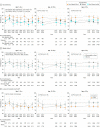Trends in Sedentary Behavior Among the US Population, 2001-2016
- PMID: 31012934
- PMCID: PMC6487546
- DOI: 10.1001/jama.2019.3636
Trends in Sedentary Behavior Among the US Population, 2001-2016
Abstract
Importance: Prolonged sitting, particularly watching television or videos, has been associated with increased risk of multiple diseases and mortality. However, changes in sedentary behaviors over time have not been well described in the United States.
Objective: To evaluate patterns and temporal trends in sedentary behaviors and sociodemographic and lifestyle correlates in the US population.
Design, setting, and participants: A serial, cross-sectional analysis of the US nationally representative data from the National Health and Nutrition Examination Survey (NHANES) among children aged 5 through 11 years (2001-2016); adolescents, 12 through 19 years (2003-2016); and adults, 20 years or older (2003-2016).
Exposures: Survey cycle.
Main outcomes and measures: Prevalence of sitting watching television or videos for 2 h/d or more, computer use outside work or school for 1 h/d or more, and total sitting time (h/d in those aged ≥12 years).
Results: Data on 51 896 individuals (mean, 37.2 years [SE, 0.19]; 25 968 [50%] female) were analyzed from 2001-2016 NHANES data, including 10 359 children, 9639 adolescents, and 31 898 adults. The estimated prevalence of sitting watching television or videos for 2 h/d or more was high among all ages (children, 62% [95% CI, 57% to 67%]; adolescents, 59% [95% CI, 54% to 65%]; adults, 65% [95% CI, 61% to 69%]; adults aged 20-64 years, 62% [95% CI, 58% to 66%]; and ≥65 years, 84% [95% CI, 81% to 88%] in the 2015-2016 cycle). From 2001 through 2016, the trends decreased among children over time (difference, -3.4% [95% CI, -11% to 4.5%]; P for trend =.004), driven by non-Hispanic white children; were stable among adolescents (-4.8% [95% CI, -12% to 2.3%]; P for trend =.60) and among adults aged 20 through 64 years (-0.7% [95% CI, -5.6% to 4.1%]; P for trend =.82); but increased among adults aged 65 years or older (difference, 3.5% [95% CI, -1.2% to 8.1%]; P for trend =.03). The estimated prevalence of computer use outside school or work for 1 h/d or more increased in all ages (children, 43% [95% CI, 40% to 46%] to 56% [95% CI, 49% to 63%] from 2001 to 2016; difference, 13% [95% CI, 5.6% to 21%]; P for trend <.001; adolescents, 53% [95% CI, 47% to 58%] to 57% [95% CI, 53% to 62%] from 2003 to 2016, difference, 4.8% [95% CI, -1.8% to 11%]; P for trend =.002; adults, 29% [27% to 32%] to 50% [48% to 53%] from 2003 to 2016, difference, 21% [95% CI, 18% to 25%]; P for trend <.001). From 2007 to 2016, total hours per day of sitting time increased among adolescents (7.0 [95% CI, 6.7 to 7.4] to 8.2 [95% CI, 7.9 to 8.4], difference, 1.1 [95% CI, 0.7 to 1.5]) and adults (5.5 [95% CI, 5.2 to 5.7] to 6.4 [95% CI, 6.2 to 6.6]; difference, 1.0 [95% CI, 0.7 to 1.3]; P for trend <.001 for both).
Conclusions and relevance: In this nationally representative survey of the US population from 2001 through 2016, the estimated prevalence of sitting watching television or videos for at least 2 hours per day generally remained high and stable. The estimated prevalence of computer use during leisure-time increased among all age groups, and the estimated total sitting time increased among adolescents and adults.
Conflict of interest statement
Figures


Similar articles
-
Associations in physical activity and sedentary behaviour among the immigrant and non-immigrant US population.J Epidemiol Community Health. 2020 Aug;74(8):655-661. doi: 10.1136/jech-2020-213754. Epub 2020 Apr 25. J Epidemiol Community Health. 2020. PMID: 32335510
-
Trends in Adherence to the Physical Activity Guidelines for Americans for Aerobic Activity and Time Spent on Sedentary Behavior Among US Adults, 2007 to 2016.JAMA Netw Open. 2019 Jul 3;2(7):e197597. doi: 10.1001/jamanetworkopen.2019.7597. JAMA Netw Open. 2019. PMID: 31348504 Free PMC article.
-
Is Cannabis Use Associated with Sedentary Behavior during Leisure Time? A Study in Canada, 2011-2012.Subst Use Misuse. 2019;54(5):852-862. doi: 10.1080/10826084.2018.1547910. Epub 2019 Jan 18. Subst Use Misuse. 2019. PMID: 30658548
-
Sedentary behaviour in youth.Br J Sports Med. 2011 Sep;45(11):906-13. doi: 10.1136/bjsports-2011-090192. Br J Sports Med. 2011. PMID: 21836174 Review.
-
Sedentary behaviour and cardiovascular disease: a review of prospective studies.Int J Epidemiol. 2012 Oct;41(5):1338-53. doi: 10.1093/ije/dys078. Epub 2012 May 26. Int J Epidemiol. 2012. PMID: 22634869 Free PMC article. Review.
Cited by
-
A systematic review of physical activity, sedentary behavior, and substance use in adolescents and emerging adults.Transl Behav Med. 2020 Oct 12;10(5):1155-1167. doi: 10.1093/tbm/ibaa008. Transl Behav Med. 2020. PMID: 33044536 Free PMC article.
-
Antiobesity and antidyslipidemic properties of Clitoria ternatea petals aqueous extract against rats induced by high-fat diet.Turk J Med Sci. 2023 Dec 18;54(2):401-410. doi: 10.55730/1300-0144.5805. eCollection 2024. Turk J Med Sci. 2023. PMID: 39050394 Free PMC article.
-
Bidirectional imputation of spatial GPS trajectories with missingness using sparse online Gaussian Process.J Am Med Inform Assoc. 2021 Jul 30;28(8):1777-1784. doi: 10.1093/jamia/ocab069. J Am Med Inform Assoc. 2021. PMID: 34100950 Free PMC article.
-
Take a load off: skeletal implications of sedentism in the feet of modern body donors.Evol Med Public Health. 2023 Dec 23;11(1):485-501. doi: 10.1093/emph/eoad041. eCollection 2023. Evol Med Public Health. 2023. PMID: 38162252 Free PMC article.
-
The Gut Microbiota and Chronic Pain.Curr Pain Headache Rep. 2024 Apr;28(4):259-269. doi: 10.1007/s11916-024-01221-x. Epub 2024 Feb 12. Curr Pain Headache Rep. 2024. PMID: 38345694 Review.

